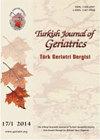急诊科老年患者30天风险评估:isar和TRST评分的比较
IF 0.3
4区 医学
Q4 GERIATRICS & GERONTOLOGY
Turkish Journal of Geriatrics-Turk Geriatri Dergisi
Pub Date : 2023-03-01
DOI:10.29400/tjgeri.2023.328
引用次数: 0
摘要
引言:这项前瞻性观察性研究的目的是比较分诊风险分层工具和风险老年人识别在识别急诊科出院后30天内有不良后果风险(返回急诊科、入院和死亡)的老年人方面的预测能力。材料和方法:在一个月的时间里,对396名年龄在65岁至98岁之间(平均76.89±7.59)的急诊患者进行了评估。这两种筛查工具都是由急诊专科医生在急诊科使用的。风险因素根据其回归系数估计值进行评分,并创建总风险评分。评估该评分的敏感性和特异性。结果:396名参与者中,198名(50%)为女性。不良结果的风险与参与者的特征之间没有观察到显著的相关性(p>0.05)。61.3%的患者的风险老年人识别(临界值≥3)呈阳性,而79%的患者的分型风险分层工具呈阳性(临界值大于或等于2)。在预测住院方面,这两个评分显著相关,并且在受试者操作特征曲线下具有相似的区域(风险老年人识别,0.63;分类风险分层工具,0.59)有风险且≥2岁的老年人使用分类风险分层工具。与分类风险分层工具相比,识别高危老年人的敏感性略高,特异性略低。关键词:急救服务、医院;老年评估;风险评估;…岁本文章由计算机程序翻译,如有差异,请以英文原文为准。
A 30-DAY RISK ASSESSMENT OF GERIATRIC PATIENTS IN THE EMERGENCY DEPARTMENT: A COMPARISON OF ISAR AND TRST SCORES
Introduction: The aim of this prospective observational study was to compare the predictive ability of the Triage Risk Stratification Tool and Identification of Seniors at Risk in identifying elderly people at risk of adverse outcomes (return to the emergency department, hospital admission, and death) within 30 days following discharge from the emergency department. Materials and Methods: 396 patients aged between 65 and 98 (mean 76.89±7.59) accessing the emergency department were evaluated over a 1-month period. Both screening tool were administered in the emergency department by emergency specialist physicians. Risk factors were assigned a score based on their regression co-efficient estimate and a total risk score was created. This score was evaluated for sensitivity and specificity. Results: Of the 396 participants, 198 (50%) were female. A significant correlation was not observed between risk of adverse outcomes and characteristics of the participant (p>0.005). The Identification of Seniors at Risk (cutoff of ≥3) was positive in 61.3% of the patients, whereas 79% were Triage Risk Stratification Tool-positive (cutoff of ≥2). The two scores were significantly correlated and had similar areas under the receiver operating characteristic curves in predicting hospital admission (Identification of Seniors at Risk, 0.63; Triage Risk Stratification Tool, 0.59). Conclusions: The predictive accuracy of the scoring systems for hospital admission after 30 days was significant at cutoff values of ≥3 for Identification of Seniors at Risk and ≥2 for Triage Risk Stratification Tool. The Identification of Seniors at Risk had slightly higher sensitivity and lower specificity than the Triage Risk Stratification Tool. Key Words: Emergency Service, Hospital; Geriatric Assessment; Risk Assessment; Aged.
求助全文
通过发布文献求助,成功后即可免费获取论文全文。
去求助
来源期刊

Turkish Journal of Geriatrics-Turk Geriatri Dergisi
GERIATRICS & GERONTOLOGY-
CiteScore
0.60
自引率
0.00%
发文量
46
审稿时长
6-12 weeks
期刊介绍:
Turkish Journal of Geriatrics is a peer-reviewed journal. Official language of the journal is English. Turkish Journal of Geriatrics invites submission of Original Articles based on clinical and laboratory studies. Review Articles are published only after the invitation from the Editorial Board.
 求助内容:
求助内容: 应助结果提醒方式:
应助结果提醒方式:


